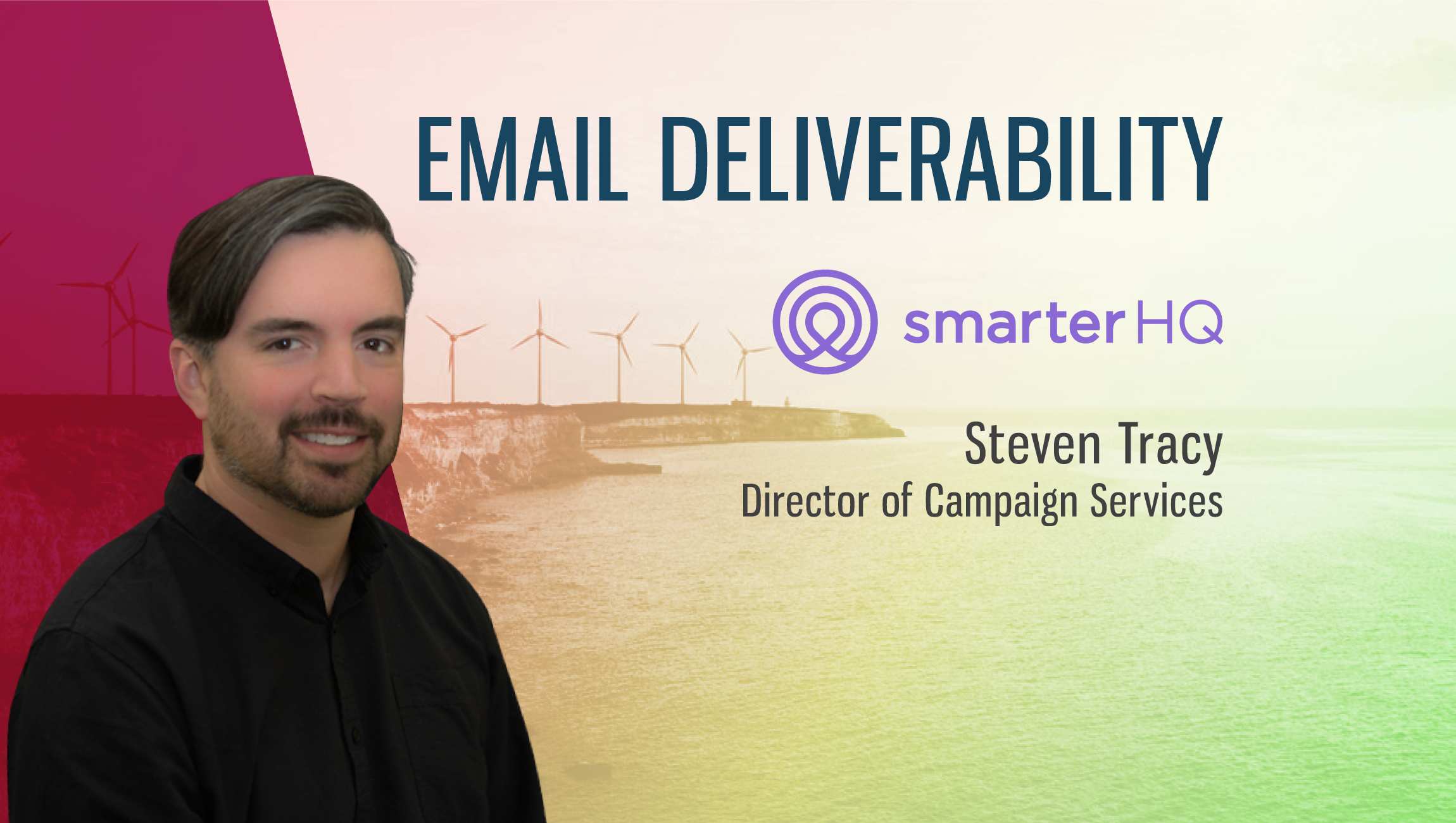Steven Tracy
Director of Campaign Services, SmarterHQ
A few years ago, segmentation and really identifying your individual subscriber was a huge part of the email marketing conversation, and predictive and behavioral intelligence takes this even further. We spoke to Steven Tracy, Director of Campaign Services at SmarterHQ, to understand the analytics that email marketing teams should focus on to identify if their tools are working well.
Html code here! Replace this with any non empty text and that's it.
Tell us about your role at SmarterHQ and the team/technology you handle.
Since 2014, I’ve led our Campaign Services team here at SmarterHQ. Our main role is to integrate clients, Email Service Providers, websites, and personalization data with our behavioral marketing platform. My team focuses on email campaign development using advanced HTML and responsive design to help clients increase conversions, and we’re dedicated to helping clients understand the possibilities of dynamic personalization in emails.
SmarterHQ is unique as it integrates with over 20 different Email Service Providers, so we work to adapt to the nuances of each ESP as it relates to our platform capabilities and ensures customers are staying compliant and following best practices to produce positive results. Along with that, we are constantly innovating to tackle complex situations as they arise to meet the evolving needs of our clients and platform.
What is the state of email deliverability in the post-GDPR era? How do you enable customers to benefit from newer data privacy regulations?
GDPR is all about consent, so when it comes to email deliverability today, if you don’t have clean data, lists, and consent from your customers and subscribers, your engagement scores, spam button hits, and so on will all begin to impact your deliverability.
The key here is good list management. At SmarterHQ, we work with a lot of different clients in different verticals, so in the weeks leading up to GDPR’s launch, we saw various issues clients might not have been aware of had the law not taken effect. For example, some clients had multiple data sets coming from various points flowing into one list, which produced duplicate records all with the same subscriber key identifier. We worked with these clients to help them define the true record that showed consent for their campaigns. Reviewing and understanding how your campaign sends classifications are set up and how unsubscribes are processed— on a regular basis — are also essential post-GDPR.
As a processor of data, SmarterHQ uses limited amounts of personal data and only for the purpose determined by the controller (our clients). We work closely with clients to help them understand the implications of new data privacy regulations for their business and for the customers they serve.
What do you mean by making predictive judgment/intelligence in email deliverability campaigns?
A few years ago, segmentation and really identifying your individual subscriber was a huge part of the email marketing conversation, and predictive and behavioral intelligence takes this even further — truly understanding that even within the segmented audience you’re targeting, the why and what they’re doing to interact with your brand, what customers are looking for in the moment, and how and when they may want to interact with you in the future. By putting all of this into perspective, you can deliver more timely and personalized emails to each segment.
Behavioral marketing campaigns definitely have the highest opens and clicks because they have the most timely, relevant content, and that alone will boost your email deliverability.
Which analytics should email marketing teams focus on to identify if their tools are working well?
SmarterHQ works with email marketing teams across Retail, Travel & Hospitality, and Financial Services, so their analytics vary for unique reasons specific to their industry, internal goals, etc. Many clients are looking to boost click-through rates and open rates, with the ultimate goal of converting customers. Others are already seeing a steady growth rate, so they are even more hyper-focused on increasing conversions. When it comes down to it, conversions are the real truth to know if your email campaign is effective — knowing if someone clicked through and actually performed the action you wanted them to take. For email marketing teams, click-throughs, opens, and conversions are all essential analytics to track.
For those looking to grow subscriber lists, bounce rates are another thing to watch; if you’re working on your lists and cleaning them regularly but still have high bounces, that’s a clear sign to alter your strategy. Also focus on how many new subscribers are coming in, campaign timing, and if the emails sent are actually getting opened by your target audience.
No two clients we work with have the same needs and goals, so just be sure to choose KPIs that align with your vertical and brand objectives.
Would you define ‘transparency’ in email marketing deliverability? How does SmarterHQ deliver committed transparency?
Clear intent, clear sender, clear user profiles and unsubscribes, clear messaging, and relevant content ensure a brand is being transparent with their email marketing. To truly be transparent, you have to make sure it’s clear to the customer what they signed up for when they submitted their information. Following best practices for clear subject lines and launching a welcome series will help with transparency, allowing the brand to lay a clear foundation with the customer and ensure they don’t think an email campaign is something it’s not.
At SmarterHQ, our job is to send relevant content, so we’re committed to being transparent about the intent of these campaigns. 70% of millennials say they are actually comfortable with retailers tracking their purchasing and browsing behaviors if it means they’ll receive more relevant communications — so personalized messaging can also build trust with your subscribers. With our clients, we always, always suggest they do things the right way and follow best practices for handling their data, managing their lists, unsubscribes, etc., but ultimately it’s up to the client with how they want to manage their subscribers and strategies.
In the GDPR era, what changes did you make to the location data strategy? How does the post-GDPR era impact the ecosystem?
There are two parts to this answer. First, GDPR does not restrict where you store data. SmarterHQ stores data in the EU for some EU clients, but in the US for others, depending on the preference of the client. Wherever the data is stored, SmarterHQ complies with GDPR rules and regulations governing the security of the data.
Second, for data collection, SmarterHQ must consider where the shopper is coming from. GDPR rules and regulations apply to EU citizens and residents. We work closely with our clients — the data controllers — to support their strategy for collecting data from shoppers who may be from the EU. Some clients use the IP address of the shopper to determine where they are from; SmarterHQ can use an IP address to restrict contact to shoppers who do not appear to be from the US. Some clients use the domain as a restriction; if the site can only ship to the country indicated by the domain, the client assumes that the shoppers must reside in the country associated with the domain: the US for .com, the UK for .uk, Germany for .de, etc.
How do you work with AI/Machine learning in email deliverability and make other personalization strategies more effective?
SmarterHQ’s behavioral marketing email campaigns are responsive to customer interactions as they are happening in real-time. We also use machine learning to run campaigns that are prescriptive to individuals based on their historical interactions.
Our platform leverages behavioral data and combines it with predictive modeling to power customer messaging based on predictions of their future shopper behavior, their propensity to convert, likelihood to churn, or potential future spend. Predictive marketing as it applies to personalization opens up a whole world of possibilities for email marketers, as it takes the guessing game out of customer intent and allows you to truly provide the right personalized message to the right person at the right time.
What are the opportunities and risks you foresee in the way email marketing is shaping up for 2020-2025? How do you prepare for these disruptions?
I can’t begin to predict the wild ride that email marketing might take in the coming years, because every time I think I have a handle on the state of email, something else changes or something new emerges. This is part of what I enjoy most about this job: the constant evolution of email marketing and the ability to master different nuances in this industry.
When disruptions happen, I keep my ear to the ground and pull the right people in — it’s important to get different opinions and expertise. With GDPR, the California laws, CAN-SPAM, or even design best practices and accessibility, be methodical about what you do, prepare early and adapt often, and expect that there will always be another disruption around the corner to tackle.
Thanks for chatting with us, Steven.
Stay tuned for more insights on marketing technologies. To participate in our Tech Bytes program, email us at news@martechseries-67ee47.ingress-bonde.easywp.com



